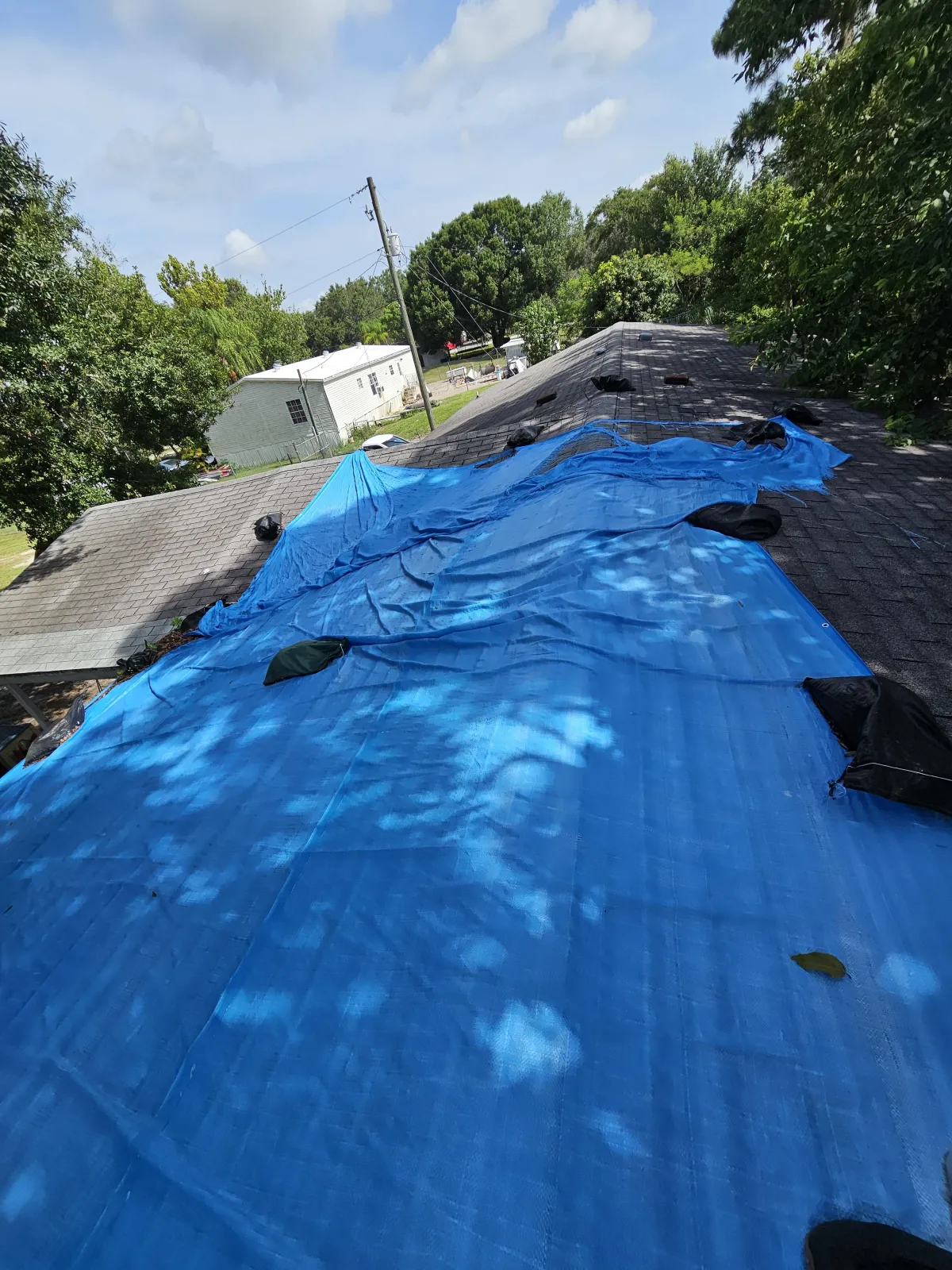
Storm Damage to Your Roof in Polk County: What to Do in the First 48 Hours
If wind or hail just rolled through and your roof looks questionable, act fast, but don’t panic. In Central Florida, most storm-related roof issues can be fixed by stabilizing the damage quickly, documenting everything, and hiring a licensed contractor for a thorough assessment. Here’s a homeowner-friendly plan for the crucial first 48 hours—so you protect your home, your wallet, and your insurance claim.
How do I tell if my roof has storm damage?
Look for problems you can see safely from the ground or through a window—don’t climb on a wet or unstable roof.
Water inside: New ceiling spots, drips around vents, or damp attic insulation.
Shingles: Missing tabs, lifted edges, creases, or piles of granules around downspouts.
Metal/tile: Bent panels, slipped/broken tiles, or exposed underlayment.
Flashing/penetrations: Torn or missing boots around pipes, satellite mounts, solar standoffs, or skylights.
Gutters/yard: Shingle pieces, nails, or debris blown off the roof.
If you’re unsure, assume moisture is present and move to stabilization steps below.
What should I do in the first 48 hours?
Follow this simple checklist to prevent further damage and keep your claim clean:
Stay safe. Avoid ladders and slick roofs. Turn off the electricity to any actively leaking light fixture.
Take photos and short videos. Capture exterior, interior, and anything weather-related (fallen limbs, blown shingles). Time-stamp if you can.
Protect belongings. Place buckets/towels, move furniture, and cover valuables with plastic sheeting.
Stabilize the roof (tarp/dry-in). If water is entering, arrange professional emergency tarping. DIY tarps often fail in the next gust and may harm your claim if they cause more damage.
Call a licensed local roofer for an inspection. Ask for a photo-documented report, not just a quote.
Notify your insurer. Provide the roofer’s photos and scope if a claim is likely.
Watch for storm-chaser scams. Don’t sign contingency contracts on the spot. Verify license and insurance (American Roofing FL: FL CCC1333453).

When is emergency tarping necessary—and how does it work?
Use tarping any time you have active leaks or clearly exposed underlayment/decking.
Purpose: Keep water out and limit interior damage until permanent repairs are made.
Method: Pros anchor tarps without creating more holes, seal edges, and route water away from penetrations.
Timeline: Same-day service is typical during storm events, with a return visit to repair/replace once materials and permits are ready.
Tip: Keep invoices—insurers usually reimburse temporary protective measures.
Will insurance cover my roof after wind or hail?
Policies vary, but here’s how it usually shakes out in Central Florida:
Covered perils: Wind, hail, and falling objects are commonly covered; flood/surge are different policies.
Repairs vs. replacement: If damage is widespread or affects the roof’s ability to shed water, carriers often lean toward replacement. Localized, isolated issues may be repairable.
Documentation wins: Photo evidence (before/after tarping, close-ups of damage, interior staining) plus a licensed roofer’s scope helps the adjuster see what you’re seeing.
Mitigation credits: A new roof meeting current code may qualify for wind-mitigation discounts.
Should I repair or replace after a storm?
It depends on roof age, extent of damage, and code compliance:
Repair when damage is isolated (a few shingles blown off, one torn boot, small flashing failure) and the roof is otherwise healthy.
Replace when there are multiple leaks on different slopes, widespread shingle creasing/granule loss, damaged underlayment/decking, or the roof is at end-of-life.
If you need a deeper dive, see our guide on storm-damage roofing in Winter Haven for what to expect during inspection, tarping, and permanent repairs.
What materials perform best in Central Florida storms?
Your home’s style and budget matter, but performance is driven by the full system—underlayment + fasteners + flashing + ventilation—not only the surface.
Architectural asphalt shingles: Cost-effective, good wind ratings when installed to code with proper nails and high-temp underlayment.
Metal roofing: Excellent wind resistance and longevity; standing-seam systems limit exposed fasteners.
Tile (concrete/clay): Very durable; the underlayment beneath tile is the real weather barrier. Properly fastened hips/ridges and foam/adhesive systems help in high wind.
Flat/low-slope: Modern membranes and coatings shed water well—details at seams, penetrations, and drains are critical.

How can I storm-harden my roof before the next season?
Proactive upgrades can reduce future losses and often pay back through longevity and insurance credits:
High-temp, self-adhered underlayment at eaves/valleys/penetrations for better water holdout.
Proper nailing pattern and ring-shank fasteners per Florida Building Code.
Sealed roof deck (secondary water barrier) where feasible.
Upgraded flashing kits at walls, chimneys, skylights, and pipe boots.
Balanced ventilation to reduce heat and pressure that can stress shingles.
Tree maintenance to keep limbs off the roof and improve wind flow.
Annual roof checkup before hurricane season to catch small issues early.
What does a professional storm inspection include?
A good contractor will provide:
Exterior/attic evaluation for leaks, soft decking, and wind-lift.
Marked photos of all affected slopes and penetrations.
Written options (stabilize → repair or replace), with timelines and warranty details.
Clear communication with your adjuster when requested.
Bottom line
In Polk County, the fastest way to minimize storm damage is to stabilize early, document well, and get a licensed roofer on site to separate cosmetic issues from true weather-entry points. From emergency tarping to full system replacements, a methodical approach keeps your home dry and your claim on track.

Book a free, no-pressure roof inspection
American Roofing FL is licensed & insured (CCC1333453) and local to Polk County. We’ll document your roof with photos, explain repair vs. replacement, and help you move forward confidently.
Schedule online: https://americanroofingfl.com/home
Call: (863) 360-6804
We also offer same-day emergency tarping during active leaks.
